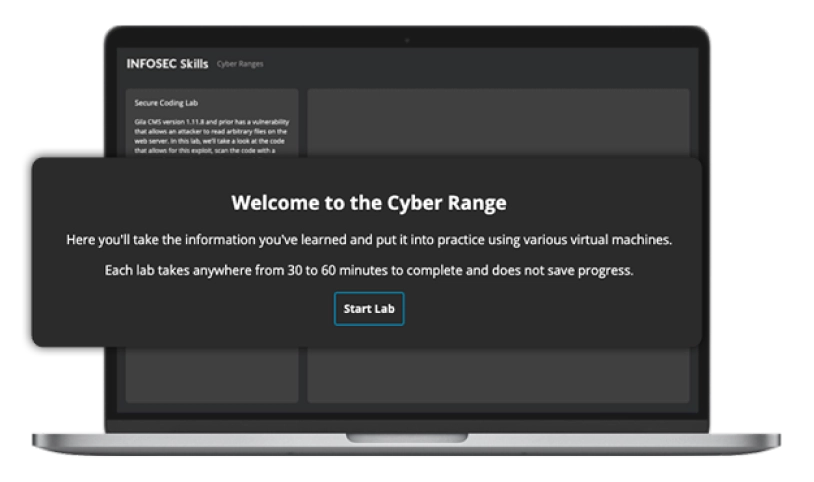
CertNexus CyberSec First Responder Learning Path
9 hours, 26 minutes
Quick facts
About this learning path
-
courses
100% online
-
Duration
9 hours, 26 minutes
-
Assessment
questions
About CertNexus CyberSec First Responder
In the CertNexus CyberSec First Responder course, you learn about cybersecurity fundamentals, including risk management, incident response, security operations and security architecture. We also cover cybersecurity's legal and ethical implications and the tools and techniques used to protect networks and systems.
You’ll learn about industry frameworks, including NIST 800-61 r.2 (Computer Security Incident Handling), US-CERT’s NCIRP (National Cyber Incident Response Plan) and Presidential Policy Directive (PPD) 41 on Cyber Incident Coordination Policy.
Ready to take the CertNexus Cyber First Responder® CFR-310 exam? Save 10% by using code VXH93HF4A when purchasing their CertNexus exam voucher here.
After purchasing the exam voucher, you will receive an email with info regarding how to register for and schedule your exam at a Pearson VUE testing center or virtual proctoring platform, OnVUE.
Who is this learning path for?
This CFR certification prep training is designed for individuals interested in taking the CertNexus Cyber First Responder® CFR-310 exam. It’s recommended for those with two to five years of experience working in a computing environment as part of a CERT, CSIRT or SOC — or as an IT professional on the front line of protecting critical information systems before, during and after a cyber incident. This includes:
- SOC Analysts who have been tasked with monitoring and detecting security incidents in information systems and networks and executing standardized responses to such incidents.
- Security Managers or other technical professionals who want to build or refresh their knowledge of incident response.
- Cybersecurity Beginners or IT professionals who have built a foundation of skills and are ready to dive into incident response and get certified.
What you should know at the end of this learning path:
- Master the objectives of the CertNexus CyberSec First Responder certification.
- Gain an understanding of the cybersecurity landscape.
- Increase your knowledge of cybersecurity threats and vulnerabilities, as well as the impact of different types of attacks.
- Acquire skills to identify and respond to different cybersecurity incidents.
- Learn techniques to protect and secure networks and systems.
- Implement penetration testing and analyze log data.
- Have the ability to develop and implement cybersecurity policies and procedures.
- Be prepared to pass your CertNexus CyberSec First Responder exam with practice exams and expert guidance.
Syllabus
CertNexus CyberSec First Responder Practice Exam
Assessment - 41 questions
CyberSec First Responder Introduction
Course - 00:04:00
Assessing Information Security Risk
Course - 01:45:00
Analyzing the Threat Landscape
Course - 00:34:00
Analyzing Reconnaissance Threats to Computing and Network Environments
Course - 00:34:00
Analyzing Attacks on Computing and Network Environments
Course - 01:07:00
Analyzing Post-Attack Techniques
Course - 00:46:00
Managing Vulnerabilities in the Organization
Course - 00:29:00
Implementing Penetration Testing to Evaluate Security
Course - 00:24:00
Collecting Cybersecurity Intelligence
Course - 00:44:00
Analyzing Log Data
Course - 00:30:00
Performing Active Asset and Network Analysis
Course - 00:54:00
Responding to Cybersecurity Incidents
Course - 00:48:00
Investigating Cybersecurity Incidents
Course - 00:25:00
The details
Learning path insights
How to claim CPEs
Should you complete this learning path, you’ll be able to download a certificate of completion. Use this to claim your CPEs or CPUs.
Associated NICE Work Roles
All Infosec training maps directly to the NICE Workforce Framework for Cybersecurity to guide you from beginner to expert across 52 Work Roles.
- All-Source Analyst
- Mission Assessment Specialist
- Exploitation Analyst
No software. No set up. Unlimited access.
Skip the server racks and spin up a realistic environment with one click. Infosec Skills cyber ranges require no additional software, hardware or server space so your team can spend less time configuring environments and more time learning. Unlimited cyber range access is included in every Infosec Skills subscription so your team can skill up however they learn best.

Unlock 7 days of free training
- 1,400+ hands-on courses and labs
- Certification practice exams
- Skill assessments
Plans & pricing
Infosec Skills Personal
$299 / year
- 190+ role-guided learning paths (e.g., Ethical Hacking, Threat Hunting)
- 100s of hands-on labs in cloud-hosted cyber ranges
- Custom certification practice exams (e.g., CISSP, Security+)
- Skill assessments
- Infosec peer community support
Infosec Skills Teams
$799 per license / year
- Team administration and reporting
- Dedicated client success manager
-
Single sign-on (SSO)
Easily authenticate and manage your learners by connecting to any identity provider that supports the SAML 2.0 standard.
-
Integrations via API
Retrieve training performance and engagement metrics and integrate learner data into your existing LMS or HRS.
- 190+ role-guided learning paths and assessments (e.g., Incident Response)
- 100s of hands-on labs in cloud-hosted cyber ranges
- Create and assign custom learning paths
- Custom certification practice exams (e.g., CISSP, CISA)
- Optional upgrade: Guarantee team certification with live boot camps
